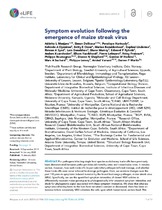| dc.contributor.author | Martin, Darren | |
| dc.contributor.author | Harkins, Gordon W | |
| dc.contributor.author | Dellicour, Simon | |
| dc.date.accessioned | 2020-12-10T12:09:02Z | |
| dc.date.available | 2020-12-10T12:09:02Z | |
| dc.date.issued | 2020 | |
| dc.identifier.citation | Harkins, G.W .et al. (2020). Symptom evolution following the emergence of maize streak virus.eLife, 9,e51984 | en_US |
| dc.identifier.issn | 2050-084X | |
| dc.identifier.uri | https://doi.org/10.7554/eLife.51984 | |
| dc.identifier.uri | http://hdl.handle.net/10566/5495 | |
| dc.description.abstract | For pathogens infecting single host species evolutionary trade-offs have previously
been demonstrated between pathogen-induced mortality rates and transmission rates. It remains
unclear, however, how such trade-offs impact sub-lethal pathogen-inflicted damage, and whether
these trade-offs even occur in broad host-range pathogens. Here, we examine changes over the
past 110 years in symptoms induced in maize by the broad host-range pathogen, maize streak virus
(MSV). Specifically, we use the quantified symptom intensities of cloned MSV isolates in
differentially resistant maize genotypes to phylogenetically infer ancestral symptom intensities and
check for phylogenetic signal associated with these symptom intensities. We show that whereas
symptoms reflecting harm to the host have remained constant or decreased, there has been an
increase in how extensively MSV colonizes the cells upon which transmission vectors feed. | en_US |
| dc.language.iso | en | en_US |
| dc.publisher | eLife Sciences Publications | en_US |
| dc.subject | Maize streak virus | en_US |
| dc.subject | South America | en_US |
| dc.subject | Maize | en_US |
| dc.subject | Food cropping | en_US |
| dc.title | Symptom evolution following the emergence of maize streak virus | en_US |
| dc.type | Article | en_US |

